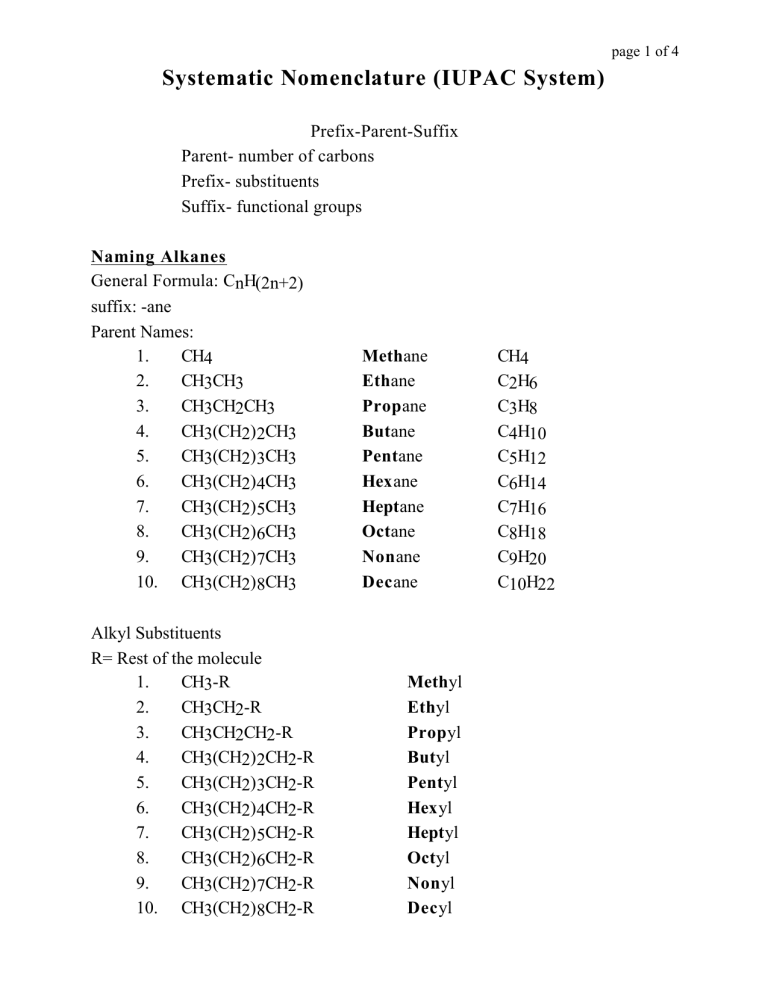
page 1 of 4
Systematic Nomenclature (IUPAC System)
Prefix-Parent-Suffix
Parent- number of carbons
Prefix- substituents
Suffix- functional groups
Naming Alkanes
General Formula: CnH(2n+2)
suffix: -ane
Parent Names:
1.
CH4
2.
CH3CH3
3.
CH3CH2CH3
4.
CH3(CH2)2CH3
5.
CH3(CH2)3CH3
6.
CH3(CH2)4CH3
7.
CH3(CH2)5CH3
8.
CH3(CH2)6CH3
9.
CH3(CH2)7CH3
10. CH3(CH2)8CH3
Alkyl Substituents
R= Rest of the molecule
1.
CH3-R
2.
CH3CH2-R
3.
CH3CH2CH2-R
4.
CH3(CH2)2CH2-R
5.
CH3(CH2)3CH2-R
6.
CH3(CH2)4CH2-R
7.
CH3(CH2)5CH2-R
8.
CH3(CH2)6CH2-R
9.
CH3(CH2)7CH2-R
10. CH3(CH2)8CH2-R
Methane
Ethane
Propane
Butane
Pentane
Hexane
Heptane
Octane
Nonane
Decane
Methyl
Ethyl
Propyl
Butyl
Pentyl
Hexyl
Heptyl
Octyl
Nonyl
Decyl
CH4
C2H6
C3H8
C4H10
C5H12
C6H14
C7H16
C8H18
C9H20
C10H22
page 2 of 4
Rules for Systematic Nomenclature of Alkanes
1. Find the parent chain
a. Identify the longest continuous carbon chain as the parent chain.
CH 3
CH 2
CH 3
7 carbons= hept-
CH
CH
CH 2
CH 3
CH 2 CH 2
CH 3
b. If more than one different chains are of equal length (number of carbons),
choose the one with the greater number of branch points (substituents) as the
parent.
CH 3
CH 3
CH 3
CH
CH
CH 2 CH 2
CH 2
CH 3
CH 3
CH 3
CH
2 branch pts.
CH
CH 2 CH 2
CH 2
CH 3
CH 3
1 branch pt.
2. Numbering the carbons of the parent chain
a. Number the carbon atoms of the parent chain so that any branch points have
the lowest possible number
1 CH
CH 3
3
7 CH 3
2 CH 2
6 CH 2
CH CH
3
4
CH 2 CH 3
CH 2 CH 2
5
6
CH 3
7
branch pts. at carbons 3 and 4
CH 3
CH
5
CH
4
CH 2 CH 3
CH 2 CH 2
3
2
CH 3
1
branch pts. at carbons 4 and 5
page 3 of 4
b. If there is branching equidistant from both ends of the parent chain, number
so the second branch point has the lowest number.
1
CH 3
2
CH 2
CH 3
CH
3
9
H3C
CH 2
CH 3
CH 2 CH 2
CH
CH
CH 2
4
6
7
8
5
CH 3
CH 3
CH 3
9
8
CH 2
CH
7
CH 2 CH 2
6
5
H3C
CH 2
CH 3
CH
4
CH
3
CH 2
2
branch pts. at carbons 3,4,7
branch pts. at carbons 3, 6, 7
3. Substituents
a. Identify and number the substituents and list them in alphabetical order.
9
8
CH 3 CH 2
CH 3
CH
7
CH 2 CH 2
6
5
H3C
CH 2
CH 3
CH
4
CH
3
CH 2
2
CH 3
1
Parent C-9 = nonane
3- ethyl
4-methyl
4,7-dimethyl
7-methyl
b. If there are two substituents on the same carbon, assign them the same
number.
4. Write out the name
a. Write out the name as a single word:
hyphens (-) separate prefixes
commas (,) separate numbers
b. Substituents are listed in alphabetical order
c. If two or more identical substituents are present use the prefixes:
di- for two
tri- for three
tetra- for four
note: these prefixes (di-, tri-, tetra-, etc.) are not used for alphabetizing
purposes.
9
8
CH 3 CH 2
H3C
CH 2
CH 3
CH
4
CH
3
CH 2
2
3- ethyl-4,7-dimethylnonane
CH 3
CH
7
CH 2 CH 2
6
5
CH 3
1
CH 3
1
page 4 of 4
5. Complex Substituents (substituents with branching)
a. Named by applying the four previous rules with some modification
b. Number the complex substituent separately from the parent. Begin
numbering at the point of attachment to the parent chain.
c. Complex substituents are set off by parenthesis.
CH 3
1
2
CH 3 CH
CH 2
3
CH 2
4
CH
5
CH 2
6
CH
CH
CH 2
2
CH 3
3
1
7
8
9
CH 2 CH 2 CH 2
10
CH 3
2,6-dimethyl-4-(1-methylpropyl)decane
CH 3
Nonsystematic (trivial) Names:
3-carbons:
H3C
Parent
Chain
CH
H3C
Isopropyl(1-methylethyl)
4-Carbons:
H 3C
CH3
CH
H 3C
Parent
Chain
H 3C
CH2
CH CH2
Parent
Chain
H 3C
CH3
sec-butyl(1-methylpropyl)
Parent
Chain
C
CH3
Isobutyl(2-methylpropyl)
tert-butyl(1,1-dimethylethyl)
5- Carbons:
CH CH2 CH2
H 3C
CH3
CH3
H 3C
Parent
Chain
H 3C
C
CH2
Parent
Chain
CH3
Isopentyl-, isoamyl
(3-methylbutyl)
neopentyl(2,2-dimethylpropyl)
H 3C
CH2
C
Parent
Chain
CH3
tert-pentyl-, tert-amyl
(1,1-dimethylpropyl)
Alphabetizing trivial names:
Iso- and neo are part of the alkyl group name and are used for alphabetizing.
sec- and tert- are not included in the alphabetical order.
